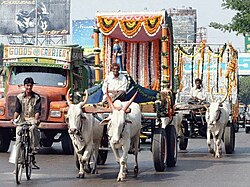Ox: Difference between revisions
m false interwiki: The German Artcile is about castrated male cattle, not about working cattle in general as this one. So Ochse is only in some cases the right translation for ox. |
|||
| Line 54: | Line 54: | ||
[[cs:Vůl]] |
[[cs:Vůl]] |
||
[[da:Okse]] |
[[da:Okse]] |
||
[[de:Ochse]] |
|||
[[et:Härg]] |
[[et:Härg]] |
||
[[es:Buey]] |
[[es:Buey]] |
||
Revision as of 23:33, 25 September 2010

An ox (plural oxen) or bullock (Australia, New Zealand, India) is a bovine animal trained as a draft animal. Oxen are commonly adult, castrated male cattle, but cows (adult females) or bulls (intact males) may also be used in some areas. Oxen are used for plowing, transport (pulling carts or wagons or sometimes for riding), threshing grain by trampling, and for powering machines for grinding grain, irrigation or other purposes. Oxen may be used to skid logs in forests, particularly in low-impact select-cut logging. Oxen are usually used in pairs: Light work such as carting on good roads might use one pair, while for heavier work further pairs are added; a team used for a heavy load over difficult ground might exceed twenty animals.
Training

Working oxen are taught to respond to the signals of the teamster (also called the bullocky or ox-driver). These signals are given by verbal command, body language, and the use of a goad, whip or a long pole (which also became used as a measure of length: see rod). In preindustrial times, many teamsters were known for their loud voices and forthright language.
Verbal commands for draft animals vary widely throughout the world. In North America, the most common verbal commands are:
- Get up: go
- Whoa: stop
- Back up: back up
- Gee: turn to the right
- Haw: turn to the left
In the New England tradition, oxen must be painstakingly trained from a young age. Their teamster must make or buy as many as a dozen yokes of different sizes as the animals grow.
In other traditions, adult cattle with little or no prior human conditioning are often yoked and trained as oxen. This is done for economy, as it is easier to let a calf be raised by its mother, and for lack of adequate methods for housing and feeding young calves.
A tradition in south eastern England was to use oxen (often Sussex cattle) as dual-purpose animals: for draft and beef. A plowing team of eight oxen normally consisted of four pairs aged a year apart. Every year, a pair of steers of about three years of age would be bought for each team and trained with the older animals. The pair would be kept for four years, then at about seven years old they would be sold to be fattened for beef – thus covering much of the cost of buying that year's new pair. Use of oxen for plowing survived in some areas of England (such as the South Downs) until the early twentieth century. Pairs of oxen were always hitched the same way round, and they were often given paired names (as in the well-known example of the names of Santa Claus's reindeer: Dasher and Dancer, Prancer and Vixen, Comet and Cupid, Donner and Blitzen). In southern England it was traditional to call the near-side (left) ox of a pair by a single-syllable name and the off-side (right) one by a longer name (for example: Lark and Linnet, Turk and Tiger).[1]
Ox trainers favor larger animals for their ability to do more work. Oxen are therefore usually of larger breeds, and are usually males because they are generally larger. Females can also be trained as oxen, but as well as being smaller, they are often more valued for producing calves and milk. Bulls are also used in many parts of the world, especially Asia and Africa.[2][3]

Uses and comparison to other draught animals
Oxen can pull heavier loads, and pull for a longer period of time than horses. On the other hand, they are also slower than horses, which has both advantages and disadvantages; their pulling style is steadier, but they cannot cover as much ground in a given period of time. For agricultural purposes, oxen were more suitable for heavy tasks such as breaking sod or ploughing in wet, heavy, or clayey, soil. When hauling freight, oxen could move very heavy loads in a slow and steady fashion. They are at a disadvantage compared to horses when it is necessary to pull a plow or load of freight relatively quickly.
For millennia, oxen also could pull heavier loads due to the use of the yoke, which was designed to work best with the neck and shoulder anatomy of cattle. Until the invention of the horse collar, which allowed the horse to engage the pushing power of its hindquarters in moving a load, horses could not pull with their full strength because the yoke was incompatible with their anatomy.
Well-trained oxen in general are also considered less excitable than horses.
See also
- Bullock cart (ox-cart)
- Bullocky (ox-driver, teamster)
- Ox-wagon (bullock wagon)
- Oxtail
- Plow
- Ridge and furrow
- Wagon
References
- ^ Copper, Bob, A Song for Every Season: A Hundred Years of a Sussex Farming Family (pp 95–100), Heinemann 1971
- ^ John C Barret (1991), "The Economic Role of Cattle in Communal Farming Systems in Zimbabwe", to be published in Zimbabwe Veterinary Journal, p 10.
- ^ Draught Animal Power, an Overview, Agricultural Engineering Branch, Agricultural Support Systems Division, Food and Agriculture Organisation of the United Nations
